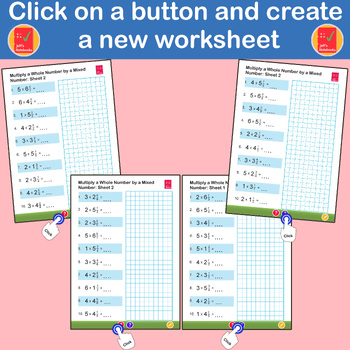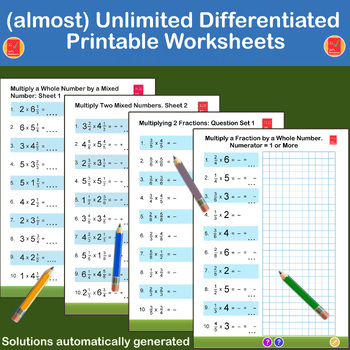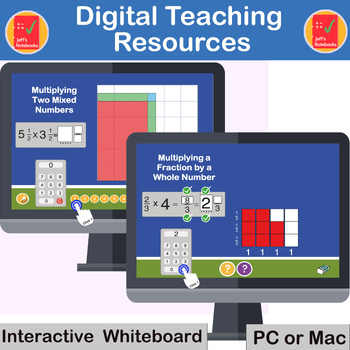Multiplying Fractions with and without Arrays
- Zip
- Easel Assessment
Description
Rectangular Arrays are an ideal visual support for understanding multiplication of fractions. This bundle provides "Interactive Teaching Pages" and "Dynamic Worksheets in 4 key areas:
- Multiplying two fractions
- Multiplying a fraction by a whole number
- Multiplying a whole number by a mixed number
- Multiplying 2 mixed numbers
There are 6 Worksheets.
All questions are randomised at the click of a button.
All the Worksheets generate solutions.
- Multiplying two fractions:
ARRAY: 6 questions with Arrays to color in - size of array reflects the question Set 1: 10 Questions, denominators 2,3,4,5,6,8.
Set 2: 10 Questions, denominators from 4 to 12. - Multiplying a fraction by a whole number
Worksheet 1: Arrays to color in - size of array reflects the question
Set 1: 6 Questions, numerator of fraction 1
Set 2: 6 Questions, numerator of fraction 1,2,3,4,5,6 or 8
Set 3: 10 Questions, numerator of fraction 1
Set 4: 10 Questions, numerator of fraction 1,2,3,4,5,6 or 8 - Multiplying a whole number by a mixed number
Set 1: 10 Questions, denominator of fraction 2,3 or 4
Set 2: 10 Questions, denominator of fraction 2 to 9 - Multiplying 2 mixed numbers
Set 1: 10 Questions, denominator of fraction 2 or 3
Set 2: 10 Questions, denominator of fraction 2,3,4,5,6 or 8
"Interactive PDF Teaching Pages" are designed for whole class teaching on an Interactive Whiteboard or on a PC/Mac computer for one-to-one tuition as a way to introduce the content of the worksheets. With each key resource there are many questions to practice and play with until you are confident the pupils can move onto the Worksheets.
There are 4 Teaching Pages
- Multiplying two fractions
- 2 Sets of Randomised questions.
- Set 1 - Numerators of both fractions are 1
- Set 2- Numerators can be 1 or more
- Multiplying a fraction by a whole number
- 2 Sets of Randomised questions
- Set 1 - Numerator of fraction is 1
- Set 2- Numerator of fraction can be 1 or more
- Multiplying a whole number by a mixed number
- 10 Examples to play with.
- Multiplying 2 mixed numbers
- 14 Examples to play with
Watch these short videos demonstrating the Interactive Teaching Pages
- Multiplying Two Fractions - Demonstration
- Multiplying a Fraction by a Whole Number - Animation
Easel Assessments
There are 4 assessment covering the 4 levels outlined above. They could initially be used to determine where to begin the teaching program and worksheets to focus on, and then as a final assessment to see if any any level of the work needs reinforcing by repeating a level with a new worksheet.
Note
This resource works with the official Adobe Acrobat Reader on Windows or Mac computers.






